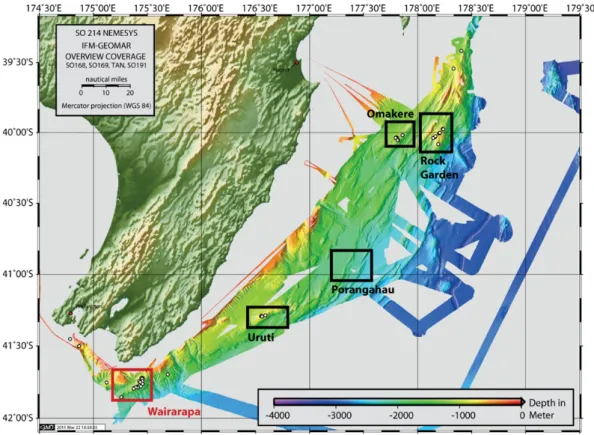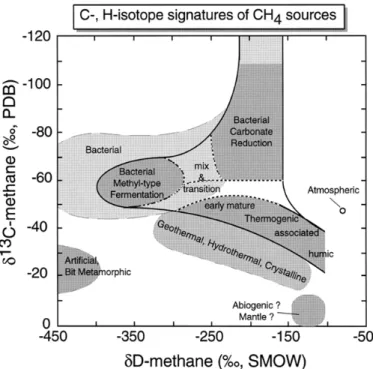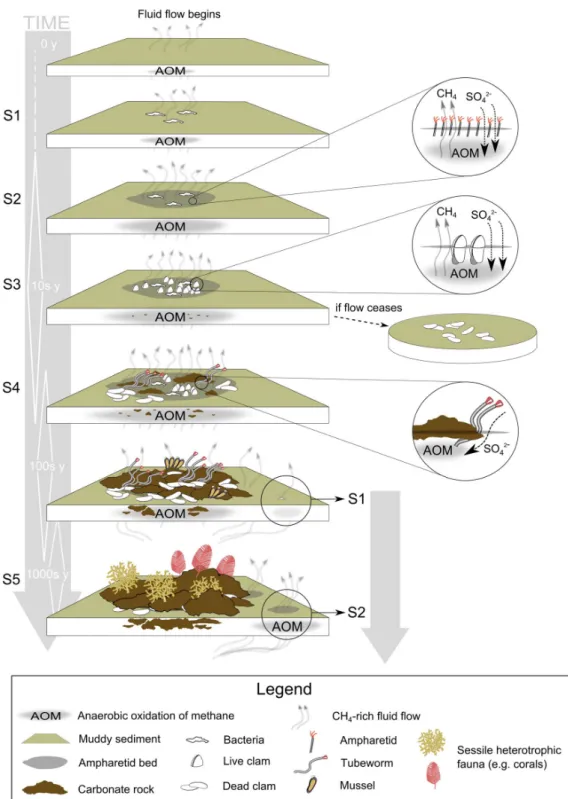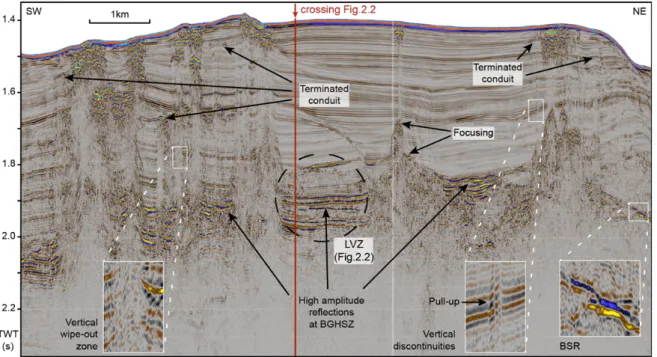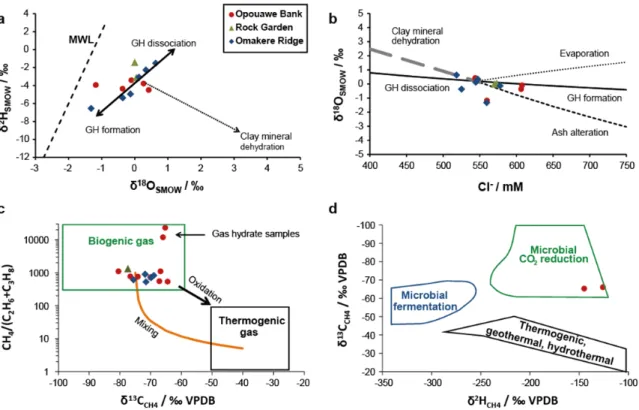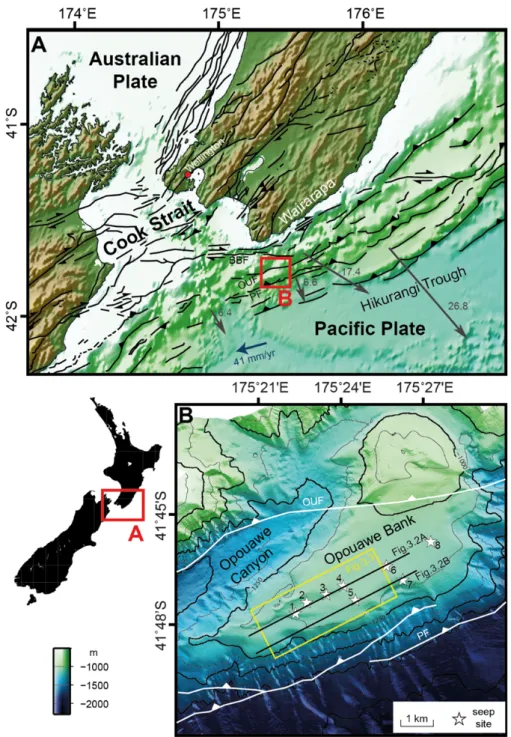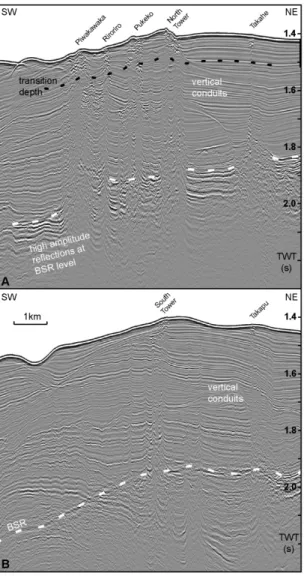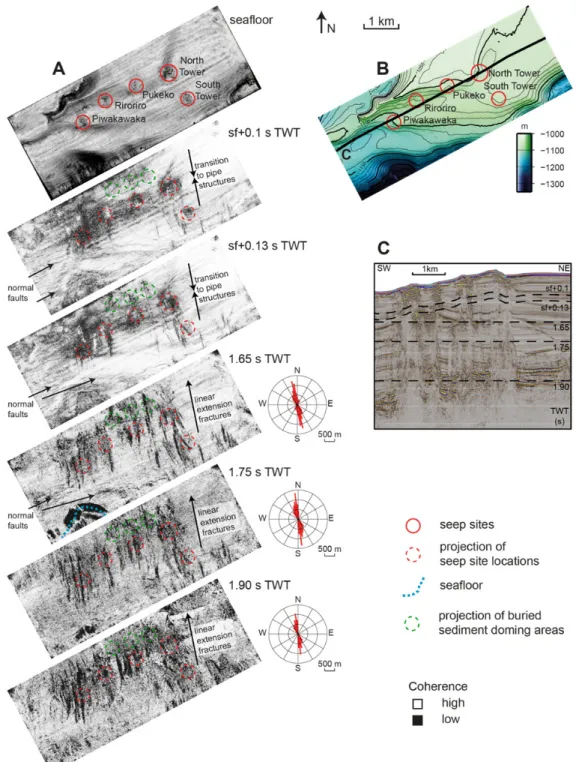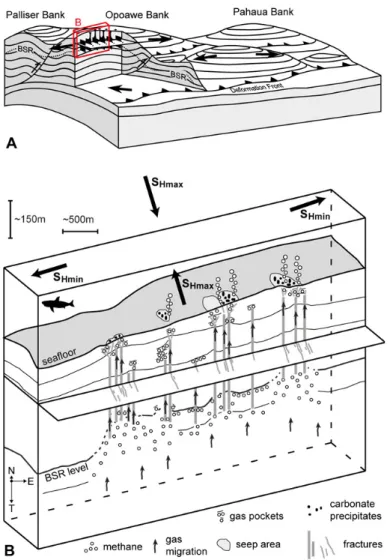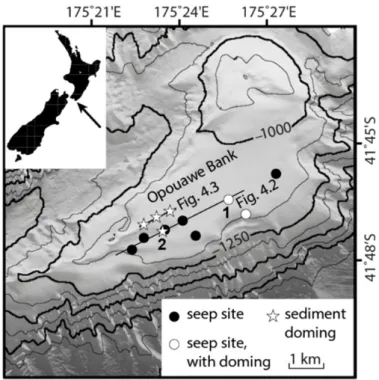Fluid Migration at Opouawe Bank, offshore New Zealand
DISSERTATION zur Erlangung des Doktorgrades
der Mathematisch‐Naturwissenschaftlichen Fakultät der Christian‐Albrechts‐Universität zu Kiel
vorgelegt von Stephanie Koch
Kiel, 2016
Referent: . . . Prof. Dr. Christian Berndt
Korreferent: . . . Prof. Dr. Sebastian Krastel‐Gudegast
Tag der mündlichen Prüfung: . . . 01. Juli 2016
Zum Druck genehmigt: . . . 01. Juli 2016
. . .
Erklärung
Hiermit erkläre ich, dass ich die vorliegende Doktorarbeit selbstständig und ohne Zuhilfenahme unerlaubter Hilfsmittel angefertigt habe. Sie stellt, abgesehen von der Beratung durch meine Betreuer, nach Inhalt und Form meine eigene Arbeit dar. Der Anteil von Koautoren an von mir verfassten und in dieser Arbeit integrierten Manuskripten ist kenntlich gemacht. Diese Arbeit wurde weder in dieser noch in einer ähnlichen Form an einer anderen Abteilung oder Hochschule im Rahmen eines Prüfungsverfahrens vorgelegt, veröffentlicht oder zur Veröffentlichung vorgelegt. Ferner versichere ich, dass die Arbeit unter Einhaltung der Regeln guter wissenschaftlicher Praxis der Deutschen Forschungsgemeinschaft entstanden ist.
Kiel, den 09. Juni 2016
. . . Stephanie Koch
Abstract
Fluid migration and its near‐surface expression is a common and wide‐spread phenomenon on subduction zone accretionary margins. Understanding the nature, variability, and lateral distribution of fluid migration has implications for the global carbon cycle, geo‐hazards (e.g. seafloor stability), and hydrocarbon exploration. Additionally, insights can be gained into the spatial and temporal processes associated with the overall subduction system.
In this framework, a cooperative study between New Zealand and Germany was launched to investigate several areas of known gas seepage off New Zealand on the Hikurangi margin. During the NEMESYS project, surveys were conducted using the R/V Sonne to gather geophysical, geochemical, and microbiological data around several vent sites, including Opouawe Bank. This study utilizes mostly geophysical data sets (2D, 3D seismic and hydro‐acoustic surveys), with some additional constraints from pore‐water geochemical analyses.
Three case studies highlight the different aspects of the gas migration systems from the gas source to the seabed. The first study links 2D multi‐channel seismic data, seismic velocity analysis, geochemical, and isotopic pore water compositions to investigate gas migration processes. Key findings include that the seepage is driven by biogenic gas migration without a substantial water phase (i.e. a “dry system”). Flow appears mostly focused into vertical conduits with some stratigraphically controlled flow along dipping horizons. The gas is generated at a maximum depth of 1,500 – 2,100 meter below seafloor (mbsf).
The use of the P‐Cable seismic system allowed 3D seismic imaging and spatial analyses of the vent systems ultimately linking these systems into the tectonic framework and overall stress regime of the accretionary prism. Migration of gas was found to be along extensional fractures systems that are elongated perpendicular to the ridge axis of Opouawe Bank. Thus, these structures are parallel to the main direction of compression induced by subduction and are the result of secondary extensional forces from the gravitational collapse of the ridge. With the reduction of overburden stress the extensional structures develop into more pipe‐like conduits in the shallow sediment at < 100 mbsf.
The shallowest expression of gas migration was investigated using hydro‐acoustic data and 2D seismic data in the third case study. Clear differences in gas migration structures suggest a progression through different evolutionary stages of seep formation. These range from channeled gas
flow, to gas trapping beneath relatively low‐permeable horizons, and overpressure accumulation associated with doming. Limits in the required height of the gas column were estimated using the spatially constrained geometry of the individual doming structure and assuming representative mechanical properties of the sediments. Contrary to ongoing discussions, this study demonstrated that these doming features can evolve into seep sites (associated with seafloor chemosynthetic communities) without the formation of pockmarks.
The combined results of these case studies suggest that the exceptional observation of extensional gas migration structures may represent a common phenomenon at convergent margins. This has implications in the overall understanding of the stress regime of the accretionary prism.
Furthermore, the study of seafloor doming yields a better understanding of gas migration and the stability of the seabed. This is relevant to improve the safety of oil and gas exploration operations and provides an additional tool to understand the mechanics of upward migrating gas through marine sediments.
Zusammenfasssung
Fluidmigration und die damit verbundene markante Beschaffenheit der meeresbodennahen Sedimente ist ein häufiges und weitverbreitetes Phänomen an akkretionären Kontinentalrändern. Das Verständnis um Art, Variabilität und lateraler Verteilung von Fluidmigration ist von allgemeiner Bedeutung für den globalen Kohlenstoffkreislauf, für Naturgefahren (wie z.B. Meeresbodenstabilität) und der Kohlenwasserstoffexploration. Außerdem können wichtige Einblicke über die räumlichen sowie zeitlichen Prozesse des gesamten Subduktionssystems gewonnen werden.
In diesem Rahmen wurde eine kooperative Studie zwischen Neuseeland und Deutschland durchgeführt, um verschiedene, von vorherigen Arbeiten schon bekannte Gasaustrittsgebiete am Hikurangi Kontinentalrand vor Neuseeland, zu untersuchen. Während dieses NEMESYS‐Projektes, wurden verschiedene geophysikalische, geochemische und mikrobiologische Messungen mit dem Forschungsschiff FS Sonne aufgenommen. Die hier vorgelegte Dissertation verwendet hauptsächlich geophysikalische Datensätze (2D, 3D seismische und hydroakustische Daten), mit zusätzlichen Informationen aus geochemischen Porenwasseranalysen.
Die verschiedenen Aspekte des Gasmigrationssystems von der Quelle bis zum Meeresboden werden durch drei Fallstudien näher beleuchtet. Die erste Studie kombiniert dafür 2D Mehrkanalseismik, seismische Geschwindigkeitsanalysen und geochemische Porenwasseranalysen, um den Gasmigrationsprozess zu untersuchen. Die wichtigsten Ergebnisse beinhalten die Erkenntnis, dass der Gasaustritt am Meeresboden fast ausschließlich durch Methan biogenen Ursprungs gespeist wird, ohne dass eine Wasserphase substantiell zum Transport (von z.B. gelöstem Methan) beiträgt, d.h. es existiert ein „trockenes Migrations‐System“. Die Gasquelle liegt dabei in einer maximalen Tiefe zwischen 1500‐2100 m unterhalb des Meeresbodens. Das aufsteigende Gas wird hauptsächlich in vertikalen Aufstiegszonen fokussiert, und nur ein geringer Teil des Gases wird entlang von Sedimentschichten transportiert.
Die Verwendung des seismischen P‐Cable Systems ermöglicht die 3D seismische Darstellung und damit eine räumliche Analyse der Fluidaustrittsstellen. Dadurch ist es zum ersten Mal gelungen, einen Zusammenhang der Fluidmigration mit dem tektonischen Spannungssystem im Akkretionskeil herzustellen. Die Studien ergaben, dass die Gasmigration durch ein vernetztes System von Bruchzonen erfolgt, wobei die Bruchzonen senkrecht zur Opouawe Bank Rückenachse orientiert
sind, und damit parallel zur Kompressionsrichtung der Subduktion. Diese, bisher nur selten beobachteten Bruchzonen sind das Ergebnis eines gravitativen Kollapses des gesamten Rückens. Die Bruchzonen entwickeln sich mit abnehmendem Auflastdruck in den oberen 100 m unterhalb des Meeresbodens zu eher zylindrischen Strukturen.
Der meeresbodennahe Teil des Gasmigrationssystems wurde in einer dritten Studie mit hydroakustischen und 2D seismischen Daten erforscht. Eine Abfolge verschiedener Entwicklungsstufen der Gasmigration wurde dabei offensichtlich. Diese Stufen beinhalten fokussierten Gasfluss, Gasakkumulation unterhalb relativ impermeabler Schichten, sowie Überdruckaufbau verbunden mit Sedimentaufwölbung. Die dafür benötigte Menge an Gas (in Form der Höhe der angestauten Gassäule) wurde anhand der Geometrie individueller Aufwölbungsstrukturen und unter Annahme repräsentativer, geomechanischer Sedimenteigenschaften berechnet. Diese Studie zeigt außerdem, dass sich Fluidaustrittsstellen (mit typischen chemo‐synthetischen Meeresbodengemeinschaften) im Gegensatz zum vorherrschenden Verständnis, direkt aus Aufwölbungsstrukturen entwickeln können, ohne dass sich Meeresbodenvertiefungen (sogenannte Pockenmarken) am Meeresboden bilden.
Die Resultate der Studien lassen darauf schließen, dass die Beobachtung von durch Extension hervorgerufenen Gasmigrationspfaden durchaus ein viel weiter verbreitetes Phänomen an konvergenten Plattenrändern darstellen könnte, als bisher angenommen. Dies kann ebenfalls zu einer verbesserten Abschätzung der Spannungsverhältnisse im Akkretionskeil beitragen. Die Studie über Sedimentaufwölbung erweitert unsere Kenntnis der Zusammenhänge von Gasmigration und Meeresbodenstabilität. Relevant sind diese Beobachtungen u.a. für Erdöl‐ und Erdgasexploration, und sie bieten ein zusätzliches Instrument für das Verständnis der vertikalen Gasmigration durch marine Sedimente.
Contents
1. Introduction 1
1.1. Motivations to study focused fluid flow ... 1
1.2. The SO‐214 NEMESYS Project ... 2
1.3. Data ... 4
1.4. Fluid flow in marine sediments ... 5
1.4.1. Cold seep systems ... 7
1.4.2. Methane gas in marine sediments ... 10
1.4.3. Gas hydrate ... 12
1.5. Fluid flow studies at the Hikurangi margin ... 14
1.6. Thesis Structure ... 17
1.7. References ... 20
2. Gas migration through Opouawe Bank 27 2.1. Abstract ... 27
2.2. Introduction ... 27
2.3. Geological setting ... 29
2.4. Materials and methods ... 31
2.4.1. Geophysical data ... 31
2.4.2. Geochemistry ... 33
2.5. Results ... 34
2.5.1. Seismics ... 34
2.5.2. Geochemistry ... 35
2.6. Discussion ... 36
2.6.1. Gas focusing ... 36
2.6.2. Gas source ... 38
2.7. Conclusions ... 39
2.8. Acknowledgements ... 40
2.9. References ... 41
3. Elongated fluid flow structures 45 3.1. Abstract ... 45
3.2. Introduction ... 46
3.3. Geological setting ... 47
3.4. Methods ... 50
3.5. Results ... 52
3.5.1. Elongated seismic anomalies ... 52
3.5.2. Transition from elongated to rounded gas migration structures ... 54
3.6. Discussion ... 55
3.6.1. The nature of the elongated seismic anomalies ... 55
3.6.2. Implikations for the stress regime ... 56
3.6.3. Shallow focusing of fluid flow conduits ... 58
3.6.4. Seep structures at the Hikurangi margin ... 58
3.7. Conclusions ... 59
3.8. References ... 60
4. Gas‐controlled seafloor doming 63 4.1. Abstract ... 63
4.2. Introduction ... 63
4.3. Data and methodes ... 65
4.3.1. Geophysical data ... 65
4.3.2. Pressure and gas column height ... 67
4.4. Results ... 69
4.5. Discussion ... 72
4.5.1. Sediment doming and seepage ... 72
4.5.2. Buried domes ... 73
4.5.3. Up‐bending versus pockmark formation ... 73
4.6. Conclusions ... 73
4.7. Acknowledgements ... 74
4.8. References ... 75
5. Conclusions and outlook 77
5.1. Summary of the key results ... 77
5.2. Implications ... 79
5.3. Outlook ... 82
5.4. References ... 85
Appendix A 87 A.1 Supplementary Material Chapter 2 ... 87
Appendix B 91 B.1 Curriculum Vitae ... 91
B.2 List of publications and presentations in the period of my PhD ... 92
B.3 Acknowledgements ... 95
List of abbreviations
2D two‐dimensional 3D three‐dimensional
AOM anaerobic oxidation of methane BGHS base of the gas hydrate stability BGHSZ base of the gas hydrate stability zone
BSR bottom simulating reflection CDP common depth point
CSEM controlled source electro‐magnetic
GC gravity cores GH gas hydrate
GHSZ gas hydrate stability zone
GI generator‐injector
IODP Integrated Ocean Drilling Program
LVZ low velocity zone mbsf meter below seafloor MCS multi‐channel seismic MUC multiple corer MWL meteoric water line
PDB Pee Dee Belemnite sf seafloor
SMOW Standard Mean Oceanwater
TWT two‐way traveltime VPDB Vienna Pee Dee Belemnite
VSMOW Vienna Standard Mean Oceanwater
1. Introduction
1.1. Motivations to study focused fluid flow
Fluid migration in marine sediments is a widespread and important geological process. The study of fluid flow systems has implications for understanding feedbacks between the global carbon reservoir, natural and exploration related hazards, seabed ecology, and global climate change. Methane (either of microbial or thermogenic origin) is the most abundant component of natural hydrocarbon gases within fossil fuel reservoirs (Claypool and Kvenvolden, 1983). The migration of fluids impacts the distribution of carbon in the subsurface and the amount seeping from the seabed (e.g. Berndt, 2005).
At cold seeps and hydrothermal vents leaking hydrocarbons nurture a wide range of chemosynthetic biological communities (e.g. Judd and Hovland, 1988) which possibly represent the earliest microbial ecosystems on Earth (Martin et al., 2008). Hydrocarbons emitted at the seabed migrate through the water column and potentially reach the atmosphere, where the gases may contribute to a positive climate feedback. Methane, for example, has a 20‐fold climate‐warming potential than carbon dioxide (e.g. Shine et al, 1990). Major climate warming events, such as the late Permian‐Triassic boundary
~253 Ma (Wignall, 2001; Retallack and Jahren, 2008), the Early Jurassic ~183 Ma (Hesselbo et al., 2000;
Svensen et al., 2007), and the Paleocen‐Eocene thermal maximum ~55 Ma (Dickens et al., 1995;
Dickens, 1999, Zachos et al., 2001) were all associated with a sudden increase in the concentration of atmospheric methane.
At continental margins, the flow of fluids through sediments is a ubiquitous process. The interplay between fluid migration, gas hydrates and seafloor seepage has strong consequences for seafloor stability, but also impacts subduction zone processes such as megathrust fault locking and depth‐
distribution of earthquakes along the subducting plate (e.g. Ranero et al., 2008; Brasse et al., 2009;
Worzewski et al., 2011). Active continental margins are very dynamic environments and marine geo‐
hazards are associated with natural events such as earthquake seismicity, slope failures, and gas venting. Trigger mechanisms for submarine slope failure are for example earthquake shaking, erosion or rapid sedimentation, but can also be connected to fluid transport and dissociation of gas hydrates where the liberation of fluids and free gas could yield substantial overpressure in the sub surface. The global gas hydrate reservoir represents a possible alternative energy resource as it
contains a (though highly disputed) vast amount of methane gas (e.g. Kvenvolden and Lorenson, 2001; Milkov, 2004; Klauda and Sandler, 2005; Wallmann et al., 2012; Piñero et al., 2013). Subduction margins contain a significant portion of that estimated global gas hydrate inventory (e.g. Kastner, 2001). The mechanics of fluid migration at convergent margins is key to understand the spatial and temporal variation of geological processes associated with the subduction system (e.g. Hensen et al., 2004; Ranero et al., 2008). Fluid migration systems can provide insights into processes of tectonic deformation, compaction of the sedimentary sequences, and the reduction of porosity. The study of cold seep may provide insights into deep‐seated processes (Kastner et al., 1991; Hensen et al., 2004).
1.2. The SO-214 NEMESYS Project
The work presented in this thesis was carried out in the framework of the NEMESYS (New Zealand methane system) project, funded by the German Federal Ministry for Education and Research (BMBF) under grant 03G0214A. In cooperation between the Leibniz Institute of Marine Science, IFM‐
GEOMAR (now GEOMAR, Helmholtz Centre for Ocean Research Kiel) and the Federal Institute of Geosciences and Natural Resources (BGR) and with partners from the Institute of Geological and Nuclear Sciences (GNS Science) as well as the Royal Netherlands Institute for Research (NIOZ), the
cruise SO214, with the German research vessel Sonne took place from 9th of March until the 22nd of April, 2011.
The NEMESYS project aimed to extend the understanding of cold vents and their variability on the Hikurangi Margin off the east coast of New Zealand’s North Island. The vent sites occur within the region of gas hydrate stability; thus, understanding the dynamics of fluid migration and hydrate formation are crucial to assess seafloor stability. Based on the results of previous expeditions (Greinert et al., 2010a; Bialas, 2011) and the preceding New Vents project (Bialas, 2007), five working areas (Fig. 1.1) were selected for expedition SO214. The objectives were to improve the knowledge of seep sites at active continental margins and review present models of the buildup of seeps and their feeder structures with respect to the tectonic regime.
Figure 1.1: Overview map of the Hikurangi Margin, offshore New Zealand’s North Island, displaying the working areas (rectangles) of the cruise SO214 Nemesys. Wairarapa area, the focus of this thesis study, is marked with a red rectangle; white dots mark known seep sites (modified after Bialas 2011).
The project pursued a multi‐scale approach with geophysical methods and geological, geo‐chemical and biological analysis to study fluid sources, migration pathways, seep habitats and the impact on the water column. The focus of this thesis is Opouawe Bank in the Wairarapa study area with the main emphasis on the geophysical survey. Opouawe Bank was selected for its dense occurrence of cold seeps with feeder channels of various expressions as seen in existing 2D seismic data. The spatial structure of the observed fluid migration pathways could not be determined from the existing 2D data. Consequently, a 3D seismic survey was acquired to image lateral dimensions with the purpose to evaluate the formation processes of the fluid migration systems.
1.3. Data
The geophysical data of the NEMESYS project presented in this thesis include 3D and new 2D multi‐
channel seismic (MCS) data and coincidently recorded high‐resolution Parasound data. The acquisition of the 3D seismic volume was constrained by expected profiling time, the optimal coverage of seep sites and the required minimum inline distance for the 3D volume. As a result, the 3 by 8 km wide area covered with seismic data comprises five seep sites (Piwakawaka, Riroriro, Pukeko, North Tower, and South Tower). The 2D seismic lines cover 3 additional seep structures (Takahe, Takapu, and Papango).
The 3D seismic data were recorded with the P‐Cable system (Fig. 1.2; Planke and Berndt, 2003) from GEOMAR, Kiel, which provides 3D data and has a much higher resolution than conventional 3D data used in hydrocarbon exploration surveys. The acquisition system consists of parallel streamer segments mounted to a cross cable. The cross cable is towed perpendicular to the heading of the vessel and spread by two trawl doors. Attached to the trawl doors are GPS antennas for navigation (Bialas, 2011). During cruise SO214, the P‐Cable system consisted of 16 parallel‐towed digital streamers, each with 8 groups of 2 hydrophones and a group distance of 1.5 m.
Figure 1.2: Sketch of the P‐Cable design applied during SO214 with 16 parallel towed streamer‐segments. A GI‐
gun was used as source. GPS was recorded on the trawl doors and on a reference antenna mounted to the ship (green dots).
For 2D MCS profiling, the 16 individual streamer segments used for the 3D survey were assembled into a continuous 200 m long digital streamer, with 128 channels at the same group spacing as above.
Three birds for depth control were mounted to the assembled 2D streamer. A single generator‐
injector (GI) gun from Sercel Marine Sources Division, with a volume of 3.8 l (105 in³ generator chamber, 105 in³ injector chamber) was the acoustic source for both 2D and 3D seismic data. The gun was operated at a shot interval of 6 s at an average ship speed of 3 kn. The MCS and the P‐Cable datasets both have a usable bandwidth (after frequency filtering) of 50 – 300 Hz.
The main processing steps of 3D seismic data included navigation correction for the 16 streamers and the source, trace editing, frequency filtering, and binning to a 3D grid with a nominal cell size of 3.125×3.125 m. A water velocity stack was the input to 3D Kirchhoff time migration, due to insensitivity of moveout velocities from short offsets. The 2D single‐streamer data processing included navigation processing, trace editing, frequency filtering, velocity filtering, and a crooked line binning with cell size of 1.5 m. After water velocity stack, a post‐stack Kirchhoff time migration with a representative velocity function below the seabed was applied.
The Parasound is an echosounder system using the parametric effect, a nonlinear acoustic interaction of two similar frequencies (e.g. 18 kHz, 22 kHz), which produce a signal with the difference‐
frequency (e.g. of 4 kHz). The advantage of the system is a controlled repeatable wavelet and a small emission cone, as the generated signal travels within the 4° angle of the original high frequency waves. The system is permanently installed on the vessel and was used to map gas flares in the water column (with the primary high frequency at 18 kHz) and to image the sediment column (with the secondary low frequency at 4 kHz). The depth penetration was up to 100 m below the seafloor with a high resolution at decimeter scale.
1.4. Fluid flow in marine sediments
Fluid flow refers to migration of liquids and gases and is a widespread natural process in marine sediments that has considerable implications for the marine environment and impacts the sediment, the seabed, and the water column. Documented for a variety of oceanographic settings, fluid flow occurs from the deep ocean to coastal areas and for different tectonic settings encompassing convergent, divergent, and transform plate boundaries, as well as intraplate setting (e.g. Lewis and Marshall, 1996; Whiticar, 2002; Dupré et al, 2010; Gay et al., 2012; Talukder, 2012; Leduc et al., 2013)
Depending on the processes inducing fluid production and migration, diverse kinds of fluid flow systems exist including hydrothermal vents (Jamtveit et al., 2004; Planke et al., 2005), cold seep systems (Sibuet and Olu‐Le Roy, 2003; Talukder, 2012), polygonal faults (Cartwright, 1994; Berndt et al., 2003) and mud volcanos (Dimitrov 2002; Kopf 2002). The types of fluid flow are affected by the fluid composition and the tectonic setting. Berndt (2005) differentiates between volcanism‐controlled, compaction‐controlled, fresh‐water and petroleum systems. Though diverse fluid flow systems with different seabed expressions exist, they all exhibit analogies in their general structure, e.g. with a fluid reservoir or source, a plumbing (feeder) system transporting the fluids, and corresponding seabed expressions (e.g. Judd and Hovland, 2007; Talukder, 2012).
Controls on focused fluid flow involve the geological environment at the source‐region of the fluids, chemical fluid composition, triggers and driving forces, and the possible existence of preferential migration pathways. In porous media, rates of fluid flow are controlled by Darcy’s law, which, in principal, describes that the permeability and pore pressure difference of the fluid flow system affect the amount of fluids passing through. Systems of low permeability may induce fractures and faults by generation of overpressure, where rates of fluid flow are dependent on the effective permeability of the conduits (e.g. Fisher et al., 2003; Jain and Juanes, 2009; Judd and Hovland, 2007 and references therein). Advection and diffusion are the common mechanisms for vertical and lateral fluid migration and are essential to explain for example the transport of methane into the gas hydrate stability zone (Liu and Flemings, 2007).
The driving forces for fluid migration in continental margins are excess pore fluid pressure (overpressure) and buoyancy (e.g. Anketell et al., 1970; Hart et al., 1995; Osborne and Swarbrick, 1997). Buoyant fluids rise towards the surface; this includes flow through permeable formations, along discontinuities and the vertical migration of gas by propagating fractures and voids in gas chimneys. Buoyancy driven fluid migration will cease if a neutral level of buoyancy is reached or a barrier prevents further fluid ascent. Permeability barriers may result in overpressure accumulation and represent a seal (Cartwright et al., 2007). Excess pore pressure can also result from the reduction of the pore volume, through compaction or compression and volume changes (Osborne and Swarbrick, 1997), for example faster gas production than dissipation. Overpressure will accumulate in the pore space underneath a seal until it exceeds the resistance to capillary entry pressure or fracture failure (Clayton and Hay, 1994). Related to excess pore pressure fracturing, plastic deformation, fluidization, sediment doming and explosive decompression may occur.
1.4.1. Cold seep systems
Cold seeps are sites where (in contrast to hydrothermal systems) cold fluids are transported from the sediment to the ocean and thereby sustaining chemosynthetic ecosystems at and near the seabed. The migration of fluids is generally linked to tectonic deformation, compaction, porosity reduction of the sedimentary sequence and mineral dehydration. Cold seeps occur at active and passive continental margins and also transform plate boundaries (Fig. 1.3, e.g. Hovland and Judd, 1988; Suess, 2014; and references therein). Active continental margins are either accretionary or erosional. Accretionary subduction zones form by sediments off‐scraping from the subducting oceanic crust and produce an accretionary wedge with ridges and sedimentary basins, which are the main source of the seep fluids.
In contrast, at erosional subduction zones a large portion of the sediment cover gets subducted together with the oceanic plate and thus undergoes a different diagenetic pathway than the accreted sediments (von Huene and Scholl 1991). At passive margins fluid flow is mainly driven by the sediment load, differential compaction, facies changes and overpressure (e.g. Berndt, 2005; Suess, 2010). Cold seep systems are windows into processes of the sub‐seafloor and provide for example clues of the source depth, fluid and sediment interaction during ascent, and fluids from clay‐
dehydration provide criteria for source temperature and depth (Kastner et al., 1991; Martin et al., 1996; Hensen et al., 2004; Suess, 2014; Riedel et al., 2010).
Cold seep systems comprise a plumbing system, where fluids migrate from the source to the seabed, and seepage features at the seafloor or in the shallow sediment (Talukder, 2012). The plumbing system is associated with structural (along fractures and faults) and stratigraphical (e.g. along bedding planes) fluid migration pathways. The internal structure and driving mechanisms of these plumbing systems are the least understood components of fluid flow systems (e.g., Judd and Hovland, 2007; Anka et al., 2012). Cold seeps are often connected with vertical focused fluid flow conduits that crosscut the sedimentary strata, which are typically described as chimneys or pipes, based on their appearance on seismic data (Riedel et al., 2002; Cartwright et al., 2007; Løseth et al., 2009; Andresen, 2012). Chimneys refer to seismically dimmed or wipe‐out zones and may reach diameters of several km (e.g. Tommeliten, Løseth et al., 2009) and pipes are typical narrow vertical seismic anomalies. Recent overview publications characterize these fluid conduits as seal bypass systems (Cartwrigth et al., 2007), hydrocarbon leakage systems (Løseth et al., 2009) and hydrocarbon plumbing systems (Talukder, 2012; Andresen, 2012).
Figure 1.3: Map of global cold seep occurrence (from Suess, 2014) with sites at passive margins incl. groundwater seeps (orange), active margins (blue), and transform margins (green).
Seafloor expressions related to cold seep activity are various: Seeping fluids may produce mounds, pingo‐like features domes, mud volcanoes, or negative morphological expressions, known as pockmarks (Judd and Hovland, 2007). Mud volcanoes are elevated morphologic features generated from ejected and extruded sediments (Kopf, 2002). Seabed domes of a small vertical extent are inferred to correlate with overpressure build‐up of accumulating gas (Hovland and Judd, 1988; Barry et al, 2012) and potentially lead to the development of pockmarks (Hovland and Judd, 1988). Pingo‐
like features are believed to result from shallow gas hydrate formation (Hovland and Svensen, 2006;
Paull et al., 2008).
Figure 1.4: Schematic overview of processes in the sediments at cold seep systems (from Roemer, 2011). The diagram shows the principle cycle from the sources to the fate of methane, and the processes leading to the consumption of dissolved methane by AOM, which fuels the chemoautotrophic communities and induces carbonate precipitations.
The dominant microbial process at cold seeps is the anaerobic oxidation of methane (AOM) coupled with sulfate reduction (Fig.g 1.4). Boetius et al. (2000) identified a consortium of methanotrophic archaea to mediate AOM. The subsequent formation of hydrogen sulfide serves as energy source for chemosynthetic organisms colonizing the seabed, such as bacterial mats, clams, mussels, and tubeworms (e.g. Sahling et al., 2002). Bacterial mats were initially discovered offshore California in the Santa Barbara Channel (Spies and Davies, 1979). AOM is an important sink for methane and limits the amount transferred to the water column and thus impacts on the global carbon cycle. The precipitation of carbonates is also a result of microbial activity at seep sites. Authigenic carbonates are potential recorders of fluid composition and venting activity (e.g. Teichert et al., 2003; Judd and Hovland, 2007) and they form small chimneys, crusts and concretions.
1.4.2. Methane gas in marine sediments
The term “fluid” encompasses liquids and gases and commonly comprises pore water and hydrocarbons. Primarily associated with fluid flow systems and the formation of gas hydrates is methane gas. It can originate from biogenic (referring to microbial and thermogenic gas) and abiogenic processes (e.g. Schoell, 1988; Welhan, 1988; Whiticar, 1999).
Biogenic methane is generated through the consumption of organic matter by microbes (e.g. Schoell, 1988). High amounts of organic matter are often related to areas of high sediment input. Microbial
methane is produced and consumed under anoxic conditions, by CO2 reduction or fermentation (Schoell, 1980; Whiticar et al., 1986). Thermogenic methane results from the transformation of organic matter under high temperatures above 80°C through thermochemical reactions. Abiogenic methane is derived from inorganic processes by thermochemical reactions (e.g. Schoell, 1988) and occurs at hydrothermal systems (Welhan, 1988).
The origin of the methane can be characterized with stable isotope analysis of carbon (C) and hydrogen (H). The resulting isotope signatures (reported in the standard δ‐notation, e.g. δ13C; δ2H or
δD) from the partitioning of light and heavy isotopes of C (12C and 13C) and H (2H and 1H) give insight into the methane generation (e.g. Rice and Claypool, 1981; Schoell, 1988; Whiticar, 1999).
Microbial gas possesses a lighter methane isotopic value (Fig. 1.5), compared to the heavier carbon isotope values typical for thermogenic methane (e.g. Whiticar, 1999). Furthermore, the proportion of methane in a hydrocarbon gas mixture differs for thermogenic and microbial gas. During microbial processes methane is produced at a significantly greater rate than higher molecular weight hydrocarbons such as ethane, propane, and butane, thus the formation processes can be deduced by combining the information of molecular weight and isotopic composition (Fig. 1.6, Bernard et al., 1976; Whiticar, 1999).
Figure 1.5: Cross plot of δ13C and δD values of methane (from Whiticar et al., 1999) for the classification of thermogenic and biogenic generated methane (PDB: Pee Dee Belemnite, standard for 13C; SMOW: Standard Mean Oceanwater).
Figure 1.6: Bernard diagram (from Whiticar, 1999) combining the molecular (C1/(C2+C3)) and isotopic (δ13C) compositional information and displaying biogenic or thermogenic origin of natural gases or mixing of both. The arrows indicate the relative compositional effects of oxidation or migration.
1.4.3. Gas hydrate
Gas hydrates are clathrates, a cage structure made up of hydrogen‐bonded water molecules and an enclosed guest molecule (e.g. Kvenvolden, 1993; Sloan and Koh, 2008). The guest molecule is a low molecular weight gas, typically methane. Three types of natural gas hydrate are known (structures I, II, and H) and the amount of methane that is incorporated depends on the structure (e.g. Sloan, 2003).
The most common is structure I, where CH4 is the main hydrate‐forming gas (Fig. 1.7), with a high capacity to store gas, as 1 m³ of hydrate contains as much as 164 m³ of methane at standard temperature and pressure conditions (Kvenvolden, 1993). Larger gas molecules, such as ethane or propane can be included in the larger cages of structure II and H (Kvenvolden, 1995; Sloan, 2003).
Figure 1.7: Structure I gas hydrate, the linked water molecules form a cage trapping a gas molecule such as methane within (Maslin et al., 2010 and references therein).
Gas hydrate stability depends (among other factors) on temperature and pressure (Fig. 1.8). Thus gas hydrate occurrence is restricted to a few global environments: The polar regions, where it is associated with permafrost, deep marine environments, such as continental margins (Beaudoin et al., 2014), and sedimentary units beneath deep lakes (e.g. Khlystov et al., 2013). Along continental margins gas hydrates usually occur in the upper few hundred meters below the seafloor at more than 300 – 500 m water depth (e.g. Kvenvolden, 1993; Ruppel, 2007; Sarkar et al., 2012)
The extent of gas hydrate stability is controlled by the relationship between the gas hydrate phase boundary and the temperature‐pressure regime of a specific setting. In marine settings local geology, sea bottom temperature, gas composition, and pore water salinity can also affect the stability of gas hydrate (Kvenvolden, 1993). The intersection of the phase boundary and the geothermal gradient defines the base of the gas hydrate stability (BGHS) and the regional gas hydrate stability zone (GHSZ) is the section between the BGHS and the seafloor. Below the GHSZ free gas may exist. The impedance contrast between gas hydrate bearing sediments (relatively high P‐wave velocity) and free gas (low P‐wave velocity) produces the bottom simulating reflection (BSR) in seismic reflection data (first identified by Shipley et al., 1979, on data around the Blake Ridge, offshore Carolina, US).
Therefore gas hydrate provinces in marine sediments can directly be inferred from BSRs.
Figure 1.8: Pressure‐temperature conditions and methane hydrate stability in marine settings (from Ruppel, 2007).
1.5. Fluid flow studies at the Hikurangi margin
At the Hikurangi Margin plenty indications for fluid flow exist, including oil, gas, and mud expulsion sites on land (Field et al., 1997), and cold vent sites offshore, which were initially inferred from fishery by‐catch in 1989 (Lewis, 1990). Exhumed onshore seep‐carbonates show that seafloor seepage is ongoing since at least 22 Ma years (Campbell et al., 2008). Over the last two decades many methane seep sites have been discovered on the margin (e.g. Lewis and Marshall, 1996; Greinert et al., 2010a). They are associated with chemosynthetic fauna (e.g. Lewis and Marshall, 1996, Faure et al., 2010; Baco et al., 2010; Bowden et al., 2013), carbonate precipitation (e.g. Liebetrau et al., 2010), acoustic anomalies in the water column (e.g. Greinert et al., 2010b), fluid migration pathways (chimneys and pipes) within the sediment (e.g. Netzeband et al., 2010, Crutchley et al., 2010a), and a wide‐spread BSR marking the BGHS (e.g. Henrys et al., 2003).
Most of the seep sites are located at the crests of accretionary ridges in the central part of the Hikurangi margin. At the southernmost expression of the Tonga‐Kermadec‐Hikurangi subduction zone, the 25 Myr old active Hikurangi margin east of New Zealand’s North Island has formed in response to the westward subduction of the Pacific Plate beneath the Australian Plate. The subduction rate is 49 mm/yr at 37°S, declines southwards to 40 mm/yr at 42°S and southwest of 42°S strike slip motion begins to dominate (DeMets et al., 2010; Collot et al., 1996; Beavan et al., 2002;
Barnes et al., 2010). While the northern margin (off Raukumara Peninsula) is dominated by tectonic erosion (Lewis et al., 1998; Collot et al., 2001), the central margin off the Wairarapa coast is a classical imbricated thrust wedge characterized by accretion (Lewis and Pettinga, 1993; Collot et al., 1996;
Barnes and de Lépinay, 1997). Per year a volume of 24 m3 of fluid per meter strike length (Townend, 1997) is added by frontal accretion to the Hikurangi margin. Consequently the abundant evidence of gas escaping offshore and onshore is released by subsequent compaction and tectonic deformation.
Figure 1.9: Hypothetical succession sequence of cold seep site communities at the Hikurangi Margin (from Bowden et al., 2013).
Related to the seep sites is a widespread gas hydrate province along the margin. It extends from ‐
38.5° S to ‐42.5° S along the margin and from water depths of 600 m eastwards, is inferred from BSRs
on seismic data (e.g. Henrys et al., 2003; Henrys et al., 2009; Greinert et al., 2010b; Bowden et al., 2013). Diffusive upward migration of methane presumable causes a semi‐continuous BSR (Kroeger et al., 2015). BSR strength has been used to illustrate the distribution and potentially highly concentrated deposits of gas hydrates (Henrys et al., 2009). Heat flow on the margin estimated from
BSR depths reveal low values of 44 ± 10 mW m−2 (e.g. Townend, 1997; Henrys et al., 2003; Pecher et al., 2010), with maximum values at the toe of the accretionary prism and decreasing landwards from the deformation front. At the flanks of the ridges high heat flow values combined with low heat flow values at the anticlines illustrate the topographic effect on subsurface temperatures (e.g. Henrys et al., 2003) and in the vicinity of seep site elevated heat flow values occur (Krabbenhoeft et al., 2013). The interaction of gas hydrate stability with tectonic uplift of a ridge (Rock Garden) was proposed to cause sediment weakening and leading to seafloor erosion (Pecher et al., 2008; Ellis et al., 2010).
Shallow deposits of gas hydrate, close to the seafloor at Rock Garden, may produce a permeability reduction, partially trapping fluids, which leads to overpressure accumulation and thus a weakening of near seafloor sediments (Crutchley et al., 2010b).
Extensive evidence for the migration of free gas into the GHSZ is reported for the Hikurangi margin, occurring along sedimentary layering across the phase‐boundary of the BSR (e.g., Crutchley et al., 2010a; Crutchley et al., 2015) and across strata through subvertical chimney or pipe structures (e.g., Netzeband et al., 2010; Krabbenhoeft et al., 2013; Plaza‐Faverola et al., 2014). The migration pathways through the GHSZ to the seabed are structurally or stratigraphically controlled (Krabbenhoeft et al., 2013).
Methane emissions at the seabed have been shown to be temporally variable and correlate with tides and currents (Krabbenhoeft et al., 2010; Klaucke et al., 2010). The seep sites along the margin feature different seabed morphologies with carbonate crusts or blocks, carbonate free seabed, and different faunal communities indicating successive stages of seep development (Fig. 1.9; Bowden et al., 2013;
Dumke et al., 2014). Geochemical analyses of authigenic carbonate samples recovered from three seep areas (Opouawe Bank, Uruti and Omakere Ridge, compare Fig. 1.1) show different phases of seep activity between 12,400± 160 and 2090± 850 years BP and intermediate intervals between 4950± 650 and 3960± 50 years BP (Liebetrau et al., 2010).
1.6. Thesis Structure
This thesis consists of an introductory chapter (Chapter 1) and three case studies that describe the diverse parts of the gas migration system at Opouawe Bank, offshore New Zealand (Chapters 2‐4), and a concluding chapter (Chapter 5). The case studies represent stand‐alone manuscripts with their own abstract, introduction, methods, results, discussion, and conclusion sections. They will be submitted (Chapter 3) and have been published (Chapter 2 and 4) in international peer‐reviewed journals.
Chapter 2 demonstrates the strength of linking geochemical and geophysical data to investigate the nature of gas migration beneath the seafloor. We show that the cold vents at Opouawe Bank, offshore New Zealand are fueled by the seepage of biogenic methane gas and provide an insight on how gas migration may affect the gas hydrate system. Accumulating free gas underneath the BGHS is generated at a maximum depth of 1500‐2100 m below the seafloor. Gas migration through Opouawe Bank is influenced by anticlinal focusing and several focusing levels within the BGHS and takes place along structurally controlled conduits and along dipping strata across the BGHS.
This chapter is published by the journal Geo‐marine Letters as Koch, S., Schroeder, H., Haeckel, M., Berndt, C., Bialas, J., Papenberg, C., Klaeschen, D., and Plaza‐Faverola, A. (2016) Gas migration through Opouawe Bank at the Hikurangi Margin, offshore New Zealand. Geo‐marine Letters 36, 187‐196. Supporting Information can be found in the Appendix A.1.
Contributions to Chapter 2: I carried out seismic analyses, prepared illustrations, and wrote the first draft of the manuscript. Matthias Haeckel contributed with the analysis and discussion of the geochemical data. Henning Schroeder and Dirk Klaeschen provided the velocity analysis based on the reprocessing of the line Pegasus_19, which was originally processed by Andreia Plaza‐Faverola and Dirk Klaeschen. C. Papenberg and D. Klaeschen processed the seismic data of the NEMESYS project. All co‐authors and external reviewers helped improving and revising the manuscript.
Chapter 3 deals with the local stress conditions within Opouawe Bank, on the Hikurangi subduction zone and the implications for the gas migration pathways. We show that gas migrates along extensional fractures through the accretionary ridge. The ridge is build up by compressive stress and secondary longitudinal extension. This enables the development of elongated pathways parallel to the most compressive stress and a transition in the upper 100 m of the sediment, to pipe‐like
structures due to declining differential stress. The observed gas migration structures are singular, but as only limited high‐resolution 3D data is available, they might be more common than thought for subduction zones and accretionary ridges.
This chapter will be submitted under the title Elongated fluid flow structures: Stress control on gas migration in Opouawe Bank, New Zealand by S. Koch, C. Berndt, G. Crutchley, D. Klaeschen, and J.
Bialas to a peer‐reviewed journal.
Contributions to Chapter 3: I analyzed the data and wrote the manuscript, with the contribution of C. Berndt, G.J. Crutchley, and J. Bialas through intensive discussions. D. Klaeschen, G.J. Crutchley, J.
Bialas, and S. Koch contributed to the acquisition of the seismic and Parasound data. J. Bialas led the survey. D. Klaeschen processed the seismic data. All co‐authors helped improving and revising the manuscript.
Chapter 4 presents a study on seafloor doming and combines both theory and field data to provide evidence for the validity of the theory of seabed doming and associated processes. Based on geo‐
mechanical quantifications, gas column heights necessary to create different dome geometries were calculated with respect to examples from Opouawe Bank, New Zealand. The process of sediment doming is considered in the analysis of evolutionary stages of seep formation. Our results suggest that the progression from channeled gas flow to gas trapping results in overpressure build‐up in the shallow sediment, which leads to doming and finally by breaching of domed seafloor sediments a new seep site can develop.
This chapter is published in the journal Geology as Koch, S., Berndt, C., Bialas, J., Haeckel, M., Crutchley, G.J., Papenberg, C., Klaeschen, D., and Greinert, J. (2015). Gas‐controlled seafloor doming. Geology 43, 571‐
574.
Contributions to Chapter 4: S. Koch, G.J. Crutchley, C. Papenberg, D. Klaeschen, and J. Greinert contributed to the acquisition of the seismic and Parasound data. J. Bialas led the survey. G.J.
Crutchley and J. Greinert processed the sediment echosounder data. C. Papenberg and D. Klaeschen processed the seismic data. I analyzed the data and wrote the manuscript, with the contribution of C.
Berndt, J. Bialas, M. Haeckel and G.J. Crutchley through intensive discussions. All co‐authors, and four external reviewers helped improving and revising the manuscript.
Chapter 5 summarizes the findings of the three previous chapters and draws integrated conclusions for the overall motivation of this study. Further, I provide an outlook on future work and follow‐up studies.
1.7. References
Andresen, K.J., 2012, Fluid flow features in hydrocarbon plumbing systems: What do they tell us about the basin evolution?: Marine Geology 332‐334, 89‐108, doi:10.1016/j.margeo.2012.07.006.
Anka, Z., Berndt, C., and Gay, A., 2012, Hydrocarbon leakage through focused fluid flow systems in continental margins: Marine Geology 332‐334, 1‐3, doi:10.1016/j.margeo.2012.10.012.
Anketell, J.M., Cegla, J., and Dzulynski, S., 1970, On the deformational structures in systems with reversed density gradients: Rocznik Polskiego Towarzystwa Geologicznego 40, 3‐30.
Baco, A.R., Rowden, A.A., Levin, L.A., Smith, C.R., and Bowden, D.A., 2010, Initial characterization of cold seep faunal communities on the New Zealand Hikurangi margin: Marine Geology 272, 251‐259, doi:10.1016/j.margeo.2009.06.015.
Barnes, P., and de Lépinay, B.M., 1997, Rates and mechanics of rapid frontal accretion along the very obliquely convergent southern Hikurangi margin, New Zealand: Journal of Geophysical Research 102, 24931‐
24952.
Barnes, P.M., Lamarche, G., Bialas, J., Henrys, S., Pecher, I.A., Netzeband, G.L., Greinert, J., Mountjoy, J.J., Pedley, K., and Crutchley, G.J., 2010, Tectonic and geological framework for gas hydrates and cold seeps on the Hikurangi subduction margin, New Zealand: Marine Geology 272, 26‐48, doi:10.1016/j.margeo.2009.03.012.
Barry, M.A., Boudreau, B.P., and Johnson, B.D., 2012, Gas domes in soft cohesive sediments: Geology 40, 379‐382, doi:10.1130/G32686.1.
Beaudoin, Y.C., Waite, W., Boswell, R., and Dallimore, S.R., 2014, Frozen Heat: A UNEP Global Outlook on Methane Gas Hydrates: United Nations Environmental Programme, GRID‐Arendal 1, 77.
Beavan, J., Tregoning, P., Bevis, M., Kato, T., and Meertens, C., 2002, Motion and rigidity of the Pacific Plate and implications for plate boundary deformation: Journal of Geophysical Research 107, doi:10.1029/2001JB000282.
Bernard, B., Brooks, J., and Sackett, W., 1976, Natural gas seepage in the Gulf of Mexico: Earth and Planetary Science Letters 31, 48‐54, doi:10.1016/0012‐821X(76)90095‐9.
Berndt, C., 2005, Focused fluid flow in passive continental margins: Philosophical Transactions of the Royal Society A: Mathematical, Physical and Engineering Sciences 363, 2855‐2871, doi:10.1098/rsta.2005.1666.
Berndt, C., Bünz, S., and Mienert, J., 2003, Polygonal fault systems on the mid‐Norwegian margin: a long‐
term source for fluid flow: Geological Society London 216, 283‐290, doi:10.1144/GSL.SP.2003.216.01.18
Bialas, J., 2011, FS SONNE Fahrtbericht / Cruise Report SO214 NEMESYS : 09.03.‐05.04.2011, Wellington ‐ Wellington, 06.‐22.04.2011 Wellington ‐ Auckland:, 1‐174 p.
Bialas, J., Greinert, J., Linke, P., and Pfannkuche, O., 2007, RV Sonne Fahrtbericht / Cruise Report SO191 ‐ New Vents “Puaretanga Hou” : Wellington ‐ Napier ‐ Auckland, 11.01. ‐ 23.03.2007: IFM‐GEOMAR Report, 1‐191 p.
Boetius, A., Ravenschlag, K., Schubert, C., and Rickert, D., 2000, A marine microbial consortium apparently mediating anaerobic oxidation of methane: Nature 407, 623‐626.
Bowden, D.A., Rowden, A.A., Thurber, A.R., Baco, A.R., Levin, L.A., and Smith, C.R., 2013, Cold seep epifaunal communities on the Hikurangi Margin, New Zealand: composition, succession, and vulnerability to human activities: PloS one 8, e76869, doi:10.1371/journal.pone.0076869.
Brasse, H., Kapinos, G., Mütschard, L., Alvarado, G.E., Worzewski, T., and Jegen, M., 2009, Deep electrical resistivity structure of northwestern Costa Rica: Geophysical Research Letters 36, L02310;
doi:10.1029/2008GL036397.
Campbell, K.A., Francis, D.A., Collins, M., Gregory, M.R., Nelson, C.S., Greinert, J., and Aharon, P., 2008, Hydrocarbon seep‐carbonates of a Miocene forearc (East Coast Basin), North Island, New Zealand: Sedimentary Geology 204, 83‐105, doi:10.1016/j.sedgeo.2008.01.002.
Cartwright, J., 1994, Episodic basin‐wide hydrofracturing of overpressured Early Cenozoic mudrock sequences in the North Sea Basin: Marine and Petroleum Geology 11, 587‐607, doi:10.1016/0264‐8172(94)90070‐1.
Cartwright, J., Huuse, M., and Aplin, A., 2007, Seal bypass systems: AAPG Bulletin 91, 1141‐1166, doi:10.1306/04090705181.
Claypool, G., and Kvenvolden, K., 1983, Methane and other hydrocarbon gases in marine sediment:
Annual Review of Earth and Planetary Sciences 11, 299‐327, doi:10.1146/annurev.ea.11.050183.001503.
Clayton, C., and Hay, S., 1994, Gas migration mechanisms from accumulation to surface: Bulletin of the Geological Society of Denmark 41, 12‐23.
Collot, J., Delteil, J., Lewis, K., Davy, B., Lamarche, G., Audru, J., Barnes, P., Chanier, F., Chaumillon, E., Lallemand, S., de Lepinay, B.M., Orpin, A., Pelletier, B., Sosson, M., et al., 1996, From Oblique Subduction to Intra‐Continental Transpression: Structures of the Southern Kermadec‐Hikurangi Margin from Multibeam Bathymetry, Side‐Scan Sonar and Seismic Reflection: Marine Geophysical Researches 18, 357‐381, doi:10.1007/BF00286085.
Collot, J., Lewis, K., Lamarche, G., and Lallemand, S., 2001, The giant Ruatoria debris avalanche on the northern Hikurangi margin, New Zealand: Result of oblique seamount subduction: Journal of Geophysical Research 106, 19271–19297, doi:10.1029/2001JB900004.
Crutchley, G.J., Pecher, I.A., Gorman, A.R., Henrys, S.A., and Greinert, J., 2010a, Seismic imaging of gas conduits beneath seafloor seep sites in a shallow marine gas hydrate province, Hikurangi Margin, New Zealand:
Marine Geology 272, 114‐126, doi:10.1016/j.margeo.2009.03.007.
Crutchley, G.J., Geiger, S., Pecher, I.A., Gorman, A.R., Zhu, H., and Henrys, S.A., 2010b, The potential influence of shallow gas and gas hydrates on sea floor erosion of Rock Garden, an uplifted ridge offshore of New Zealand: Geo‐Marine Letters 30, 283‐303, doi:10.1007/s00367‐010‐0186‐y.
Crutchley, G.J., Fraser, D.R.A., Pecher, I.A., Gorman, A.R., Maslen, G., and Henrys, S.A., 2015, Gas migration into gas hydrate‐bearing sediments on the southern Hikurangi margin of New Zealand:, 1‐19, doi:10.1029/2001.
DeMets, C., Gordon, R.G., and Argus, D.F., 2010, Geologically current plate motions: Geophysical Journal International, v. 181, no. 1, p. 1‐80, doi: 10.1111/j.1365‐246X.2009.04491.x.
Dickens, G., OʹNeil, J., Rea, D., and Owen, R., 1995, Dissociation of oceanic methane hydrate as a cause of the carbon isotope excursion at the end of the: Paleoceanography 10, 965‐971, doi:10.1029/95PA02087.
Dickens, G.R., 1999, Carbon cycle: The blast in the past: Nature 401, 752‐755, doi:10.1038/44486.
Dimitrov, L., 2002, Mud volcanoes—the most important pathway for degassing deeply buried sediments:
Earth‐Science Reviews 59, 49‐76, doi:10.1016/S0012‐8252(02)00069‐7.
Dumke, I., Klaucke, I., Berndt, C., and Bialas, J., 2014, Sidescan backscatter variations of cold seeps on the Hikurangi Margin (New Zealand): indications for different stages in seep development: Geo‐Marine Letters 34, 169‐184, doi:10.1007/s00367‐014‐0361‐7.
Dupré, S., Woodside, J., Klaucke, I., Mascle, J., Foucher, J.‐P., 2010, Widespread active seepage activity on the Nile Deep Sea Fan (offshore Egypt) revealed by high‐definition geophysical imagery: Marine Geology 275, 1–
19.
Ellis, S., Pecher, I., Kukowski, N., Xu, W., Henrys, S., and Greinert, J., 2010, Testing proposed mechanisms for seafloor weakening at the top of gas hydrate stability on an uplifted submarine ridge (Rock Garden), New Zealand: Marine Geology 272, 127‐140, doi:10.1016/j.margeo.2009.10.008.
Faure, K., Greinert, J., Schneider v.D., J., McGinnis, D.F., Kipfer, R., Linke, P., 2010, Methane seepage along the Hikurangi Margin of New Zealand: Geochemical and physical data from the water column, sea surface and atmosphere: Marine Geology 272, 170–188.
Field, B.D., Uruski, C.I., et al., 1997. Cretaceous–Cenozoic Geology and Petroleum Systems of the East Coast Region, New Zealand. Institute of Geological & Nuclear Sciences Monograph 19, Institute of Geological &
Nuclear Sciences Ltd, Lower Hutt, New Zealand. 301 pp.
Fisher, Q., Casey, M., Harris, S., and Knipe, R., 2003, Fluid‐flow properties of faults in sandstone: the importance of temperature history: Geology 31, 965‐968, doi:10.1130/G19823.1.
Gay, A., Mourgues, R., Berndt, C., Bureau, D., Planke, S., Laurent, D., Gautier, S., Lauer, C., Loggia, D., 2012,. Anatomy of a fluid pipe in the Norway Basin: Initiation, propagation and 3D shape: Marine Geology 332–
334, 75‐88.
Greinert, J., Bialas, J., Lewis, K., and Suess, E., 2010a, Methane seeps at the Hikurangi Margin, New Zealand: Marine Geology 272, 1‐3, doi:10.1016/j.margeo.2010.02.018.
Greinert, J., Lewis, K.B., Bialas, J., Pecher, I.A., Rowden, A., Bowden, D.A., de Batist, M.D., de Batist, M., and Linke, P., 2010b, Methane seepage along the Hikurangi Margin, New Zealand: Overview of studies in 2006 and 2007 and new evidence from visual, bathymetric and hydroacoustic investigations: Marine Geology 272, 6‐
25, doi:10.1016/j.margeo.2010.01.017.
Hart, B., Flemings, P., Deshp, A., and e, 1995, Porosity and pressure: Role of compaction disequilibrium in the development of geopressures in a Gulf Coast Pleistocene basin: Geology 23, 45‐48, doi:10.1130/0091‐
7613(1995)0232.3.CO;2.
Henrys, S.A., Ellis, S., and Uruski, C., 2003, Conductive heat flow variations from bottom‐simulating reflectors on the Hikurangi margin, New Zealand: Geophysical Research Letters 30, 1‐4, doi:10.1029/2002GL015772.
Henrys, S.A., Woodward, D.J., and Pecher, I.A., 2009, Variation of bottom‐simulating‐reflection strength in a high‐flux methane province, Hikurangi margin, New Zealand, in Collett, T., Johnson, A., Knapp, C., and Boswell, R. tran., 2009, AAPG Memoir, 481 – 489.
Hensen, C., Wallmann, K., Schmidt, M., Ranero, C.R., and Suess, E., 2004, Fluid expulsion related to mud extrusion off Costa Rica—A window to the subducting slab: Geology 32, 201, doi:10.1130/G20119.1.
Hesselbo, S., Gröcke, Jenkyns, H., and Bjerrum, C., 2000, Massive dissociation of gas hydrate during a Jurassic oceanic anoxic event: Nature 406, 392‐395, doi:10.1038/35019044.
Hovland, M., and Judd, A., 1988, Seabed pockmarks and seepages: impact on geology, biology, and the marine environment:. Springer.
Hovland, M., and Svensen, H., 2006, Submarine pingoes: Indicators of shallow gas hydrates in a pockmark at Nyegga, Norwegian Sea: Marine Geology 228, 15‐23, doi:10.1016/j.margeo.2005.12.005.
Huene, von, R., and Scholl, D.W., 1991, Observations at convergent margins concerning sediment subduction, subduction erosion, and the growth of continental crust: Reviews of Geophysics 29, 279‐316, doi:10.1029/91RG00969.
Jain, A.K., and Juanes, R., 2009, Preferential Mode of gas invasion in sediments: Grain‐scale mechanistic model of coupled multiphase fluid flow and sediment mechanics: Journal of Geophysical Research 114, 1‐19, doi:10.1029/2008JB006002.
Jamtveit, B., Svensen, H., Podladchikov, Y.Y., and Planke, S., 2004, Hydrothermal vent complexes associated with sill intrusions in sedimentary basins: Geological Society, London, Special Publications 234, 233‐
241.
Judd, A., and Hovland, M., 2007, Seabed fluid flow: the impact of geology, biology and the marine environment, Cambridge University Press.
Kastner, M., Elderfield, H., and Martin, J.B., 1991, Fluids in convergent margins: What do we know about their composition, origin, role in diagenesis and importance for oceanic chemical fluxes?: Philos. Trans. R. Soc.
London A, 335, 243–259.
Kastner, M., 2001, Gas hydrates in convergent margins: formation, occurrence, geochemistry, and global significance, in Paull, C.K. and Dillon, W.P. tran., Natural Gas Hydrates: Occurrence, American geophysical union geophysical monograph, 67‐86.
Khlystov, O., de Batist, M.D., de Batist, M., Shoji, H., Hachikubo, A., Nishio, S., Naudts, L., Poort, J., Khabuev, A., Belousov, O., Manakov, A., and Kalmychkov, G., 2013, Gas hydrate of Lake Baikal: Discovery and varieties: Journal of Asian Earth Sciences 62, 162‐166, doi:10.1016/j.jseaes.2012.03.009.
Klaucke, I., Weinrebe, W., Petersen, C.J., and Bowden, D., 2010, Temporal variability of gas seeps offshore New Zealand: Multi‐frequency geoacoustic imaging of the Wairarapa area, Hikurangi margin: Marine Geology 272,, 49‐58, doi:10.1016/j.margeo.2009.02.009.
Klauda, J.B., and Sandler, S.I., 2005, Global distribution of methane hydrate in ocean sediment: Energy Fuels 19, 459–470.
Koch, S., Berndt, C., Bialas, J., Haeckel, M., Crutchley, G.J., Papenberg, C., Klaeschen, D., and Greinert, J. , 2015, Gas‐controlled seafloor doming: Geology 43, 571‐574, doi: 10.1130/G36596.1.
Koch, S., Schroeder, H., Haeckel, M., Berndt, C., Bialas, J., Papenberg, C., Klaeschen, D., and Plaza‐
Faverola, A., 2016, Gas migration through Opouawe Bank at the Hikurangi Margin, offshore New Zealand: Geo‐
marine Letters 36, 187‐196, doi: 10.1007/s00367‐016‐0441‐y.
Kopf, A.J., 2002, Significance of mud volcanism: Reviews of Geophysics 40, 1‐52, doi:10.1029/2000RG000093.
Krabbenhoeft, A., Bialas, J., Klaucke, I., Crutchley, G., Papenberg, C., and Netzeband, G.L., 2013, Patterns of subsurface fluid‐flow at cold seeps: The Hikurangi Margin, offshore New Zealand: Marine and Petroleum Geology 39, 59‐73, doi:10.1016/j.marpetgeo.2012.09.008.
Krabbenhoeft, A., Netzeband, G.L., Bialas, J., and Papenberg, C., 2010, Episodic methane concentrations at seep sites on the upper slope Opouawe Bank, southern Hikurangi Margin, New Zealand: Marine Geology 272, 71‐78, doi:10.1016/j.margeo.2009.08.001.
Kroeger, K.F., Plaza‐Faverola, A., Barnes, P.M., and Pecher, I.A., 2015, Thermal evolution of the New Zealand Hikurangi subduction margin: Impact on natural gas generation and methane hydrate formation ‐ A model study:, 1‐18, doi:10.1016/j.marpetgeo.2015.01.020.
Kvenvolden, K.A., and Lorenson, T.D., 2001, The global occurrence of natural gas hydrate: Geophys.
Monogr. 124, 87–98.
Kvenvolden, K., 1995, A review of the geochemistry of methane in natural gas hydrate: Organic Geochemistry.
Kvenvolden, K.A., 1993, Gas Hydrates—Geological Perspective and Global Change: Reviews of Geophysics 31, 173‐187, doi:10.1029/93RG00268.
Leduc, A.M., Davies, R.J., Swarbrick, R.E., and Imber, J., 2013, Fluid flow pipes triggered by lateral pressure transfer in the deepwater western Niger Delta: Marine and Petroleum Geology 43, 423‐433.
Lewis, K.B., 1990, Seep faunas and limestone chimneys: Professional fisherman 4,16–17.
Lewis, K.B., and J.R. Pettinga, 1993, The emerging, imbricate frontal wedge of the Hikurangi margin, in Sedimentary Basins of the World 2, Sedimentary Basins, edited by P.F. Ballance, pp. 225‐250, Elsevier Sci., New York, 1993.
